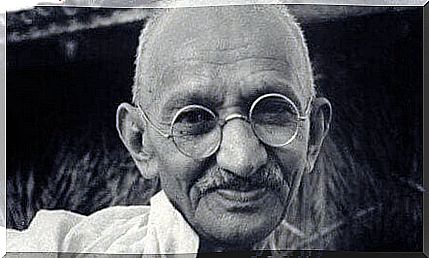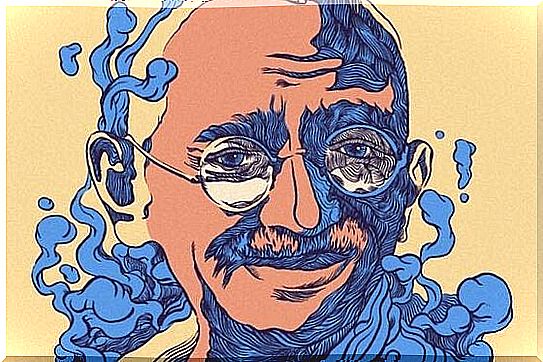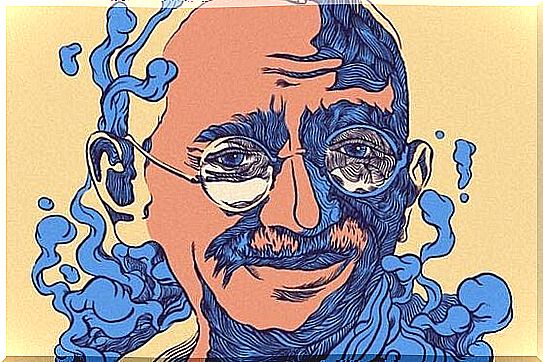Mahatma Gandhi: Biography Of The Leader Of Non-violence

The legacy of Mohandas K. Gandhi, better known as Mahatma (great soul), still lives among us. It is this man who, by his humility, wanted to launch a peaceful revolution to defend the civil rights of his country. He established himself as a political and spiritual leader capable of inspiring not only an entire country like India. Its wake and nonviolent disobedience have conquered the whole world.
Every October 2, we celebrate the day of non-violence. Beyond his political and social goals, what Gandhi proposed to our contemporary history was a style of thought, a philosophy of life.
During his nearly three decades of peaceful activism, he did not just want to free his people from the British Raj. His goals were higher. He defended social justice, aspired to the transformation of economic structures. Gandhi laid the foundations for a more active ethics of the human being. He taught us that harmony between religions could be possible among different peoples.
Gandhi: from a naive lawyer to a brilliant activist
Mohandas K. Gandhi was born in Porbandar in 1869. He belonged to a distinguished caste of late 19th century India. In fact, his father was Prime Minister of Gujarat. Her mother, belonging to the branch of Hinduism, was a woman who stood out for her tolerance and for the defense of peaceful coexistence among all religions.
He grew up from an early age in a privileged environment in every sense of the word: financial ease, harmony and spirituality. He was a vegetarian and very attached to all the traditional knowledge of his culture.
However, his family chose him from among his two older brothers in order to continue his academic training. For this he was sent to London in 1888 to study law. This stage of his life away from India, which lasted nearly two decades, was crucial in building his identity, social activism and philosophical conviction.
In England he came into contact with the circle of Theosophists, who initiated him into the Bahagavad Gita, the holy book of the Hindus. This book inspired him decisively in his religious ideals and principles.
After graduating, the inexperienced lawyer traveled to South Africa, a divided and unstable country made up of several colonies ruled by the British and the Dutch. It was in this context that a decisive stage in his life began. The young lawyer suddenly became a strong advocate for equality and freedom.
It is in South Africa that these four characteristics that define Mahatma Gandhi were developed:
- Defender of freedom
- Social reformer
- Defender of the tolerance of all religions
- Spiritual leader

The struggle for Indian independence
When Gandhi returned to his country in 1915, things had accelerated in India. The vote of a law aiming to prohibit the suffrage of the Hindus was then envisaged. It was then that he began to apply the same social activism that he had already started to establish in South Africa. He called his people to resistance and to Satyagraha (the creed of non-violence).
The world, in turn, brought the echoes of the First World War, and it begins to lay the foundations for India’s peaceful independence. To do this, he used a tactical and intellectual approach that was as innovative as it was inspiring for several generations. Mahatma Gandhi creates a farm in the city of Ahmedabad to gather his followers.
He becomes a spiritual leader who inspires several communities. Little by little, more peaceful settlements are created, which ignites the engines of a great revolution.
One effective strategy was to stop the production of cotton, a key component of the British textile industry. It would do the same with the British salt monopoly. Civil disobedience campaigns have claimed the lives of thousands of people. He also had to go to jail. However, the goal was then achieved: the independence of India as a British colony came on August 18, 1947.
A few months later, on January 30, 1948, Gandhi was killed by the Hindu extremist Nathuram V. Godse in the middle of a crowd. He was 78 years old.
Gandhi’s Guidelines on Satyagraha (Creed of Nonviolence)
Sa tyagraha was a word coined by Gandhi himself to represent his struggle, which was based on this firm resistance which was not to resort to violence.
Thus, this humble and firmly obstinate man in his turn to defend social rights (to the point of being nominated 5 times for the Nobel Peace Prize) insisted that life be indivisible and, as such, he is inconceivable that one person can cause harm to another. Therefore, any active struggle for the good and defense of the sufferer must be based on satyagraha. It is a dimension that includes the following principles:
- Use the truth
- ?? Do not steal
- Respect any religion
- Believe in truth and non-violence and have faith in the intrinsic goodness of human nature.
- Knowing that a civilian resistance fighter will not feel anger or hatred
- Support the assaults of his opponent, without backing down or feeling fear
- Accept to be arrested
- Know that the resistant will refuse to give up its properties
- Avoid revenge
- Do not insult
- Don’t salute the UK flag, but don’t insult it either
- Protect officials from attacks and insults
Conclusions on Gandhi’s work
Gandhi made an undeniable change in twentieth century thinking. He left an inspiring trail, like Martin Luther King in his day or Mandela himself years later. This type of heritage is undoubtedly a challenge for our society today. Collecting the testimonies and learning from these numbers is something we should all think about in order to improve the course of our civilization.










